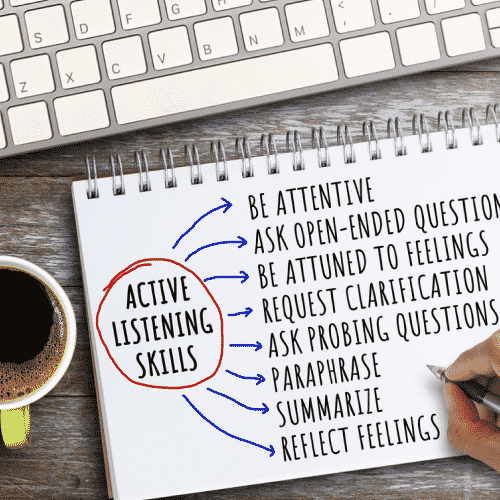By Azrung Fayaz, Doctor of Internal Medicine | MBBS, FCPS, MRCP
Updated on February 13, 2024
Published on December 14, 2023
Fact Checked

Get latest news, updates, and trends on mental well-being

Imagine turning an awkward dinner table discussion into a meaningful exchange. But that’s easier said than done, right? Let’s face it: families are more disconnected today than ever before. In fact, 51% of fathers feel their connection with their children weakens as they grow.1
In comparison, people note mental health improvements after healthy family meetings.2 This shows the power of effective communication. By communicating effectively, you can strengthen your family ties.
This blog will break down ten vital skills to enhance your family interactions. For example, you’ll learn how to express yourself and listen. Let’s dive in and discover how to make your conversations count.
Active listening helps everyone feel important and understood. Studies3 show that when people feel heard, they value the conversation more. But if they feel ignored, they don’t want to talk. Another study4 found that listening to people’s experiences can protect their mental health.

When you listen well, you build trust. It creates a safe space where everyone can share openly and honestly. It’s not just about the words but also about understanding feelings and body language. This can stop minor misunderstandings from becoming big problems.
Focusing on how someone looks or moves can tell you how they feel. This helps everyone feel closer and more understood.
To incorporate non-verbal cues in family conversations, use:
Empathy adds understanding, care, and a real sense of connection. Imagine a chat where everyone gets where you’re coming from. That’s empathy at work.
Studies5 show that caring about other people’s feelings can strengthen your relationships. For example, when a mom shows empathy, it helps her connect with her teenagers.6 This is because empathy creates a place where it’s safe to share feelings without fear. Thus, in tough times, compassion turns your family into a team.
How you talk can change how a family conversation goes because words are powerful. They help you share what you’re feeling and thinking. So, by choosing the right words, you can turn feelings like anger or fear into something you can discuss.

Here’s how you can be mindful of your tone and language:
Studies7 show that gratitude can make you feel less stressed. It also brings everyone closer and makes your family stronger. When you show appreciation, you tell your family you see and value what they do.

Practice gratitude by:
It’s vital to solve problems in a way that makes everyone feel heard and understood. Good conflict resolution can prevent negative feelings from lasting too long.

Different families have their own ways of approaching problems.8 For instance, some families talk it out. On the other hand, some families prefer not to discuss their issues.
With that said, you can follow some simple steps to resolve family conflicts. These include:

Jumping to conclusions can cause trouble. It often hurts feelings. This is because assumptions can create misunderstandings. To avoid such a situation, you can ask when unsure about something. Likewise, you can repeat what someone says in your own words to check if you understood it right.
Boundaries help everyone feel safe and respected. This way, no one makes others uncomfortable. Thus, family gatherings become more fun.
Understandably, a mental health expert, Stephanie Cox, says setting clear boundaries is good for you. Here’s a simple guide to setting boundaries:
Talking clearly and straight to the point helps everyone understand each other better. This way, everyone can share their ideas openly and honestly. It also makes sure no one feels left out or misunderstood.
A study9 found that families who learned to talk more clearly had less depression and anxiety. These families were also less stressed.
To communicate clearly:

Taking turns speaking makes sure that everyone gets a chance to share their thoughts. It also helps everyone listen better. This way, all ideas get heard and respected. For example, a study10 showed that when people take turns in group talks, they think better together. It also helps avoid unfair situations where some talk more than others.
Improving family communication is all about respect, patience, and understanding. Remember to listen to each other, pay attention to body language, and show empathy. Choose your words and tone carefully to keep the conversation positive. Appreciating each other’s efforts can also bring families closer.
Likewise, work together to solve conflicts and respect each other’s boundaries. Be clear and direct in your communication, and make sure everyone gets a chance to speak. This way, you can create a happier, more understanding family environment.
2. Ac OC, Caporino NE, O’Brien MP, Miklowitz DJ, Addington JM, Cannon TD. Family communication and the efficacy of family focused therapy in individuals at clinical high risk for psychosis with comorbid anxiety. Early Interv Psychiatry. 2023;17(3). doi:10.1111/eip.13326
3. Alsawy S, Tai S, McEvoy P, Mansell W. “It”s nice to think somebody’s listening to me instead of saying “oh shut up”’. People with dementia reflect on what makes communication good and meaningful. J Psychiatr Ment Health Nurs. 2020;27(2). doi:10.1111/jpm.12559
5. Boele S, Van der Graaff J, de Wied M, Van der Valk IE, Crocetti E, Branje S. Linking Parent-Child and Peer Relationship Quality to Empathy in Adolescence: A Multilevel Meta-Analysis. J Youth Adolesc. 2019;48(6). doi:10.1007/s10964-019-00993-5
6. Crocetti E, Moscatelli S, Van der Graaff J, Keijsers L, van Lier P, Koot HM, et al. The Dynamic Interplay among Maternal Empathy, Quality of Mother-Adolescent Relationship, and Adolescent Antisocial Behaviors: New Insights from a Six-Wave Longitudinal Multi-Informant Study. PLoS One. 2016;11(3). doi:10.1371/journal.pone.0150009
7. Komase Y, Watanabe K, Hori D, Nozawa K, Hidaka Y, Iida M, et al. Effects of gratitude intervention on mental health and well‐being among workers: A systematic review. J Occup Health. 2021;63(1). doi:10.1002/1348-9585.12290
9. Ghazavi Z, Feshangchi S, Alavi M, Keshvari M. Effect of a Family-Oriented Communication Skills Training Program on Depression, Anxiety, and Stress in Older Adults: A Randomized Clinical Trial. Nursing and midwifery studies. 2016;5(1). doi:10.17795/nmsjournal28550
10. Theobald EJ, Eddy SL, Grunspan DZ, Wiggins BL, Crowe AJ. Student perception of group dynamics predicts individual performance: Comfort and equity matter. PLoS One. 2017;12(7). doi:10.1371/journal.pone.0181336